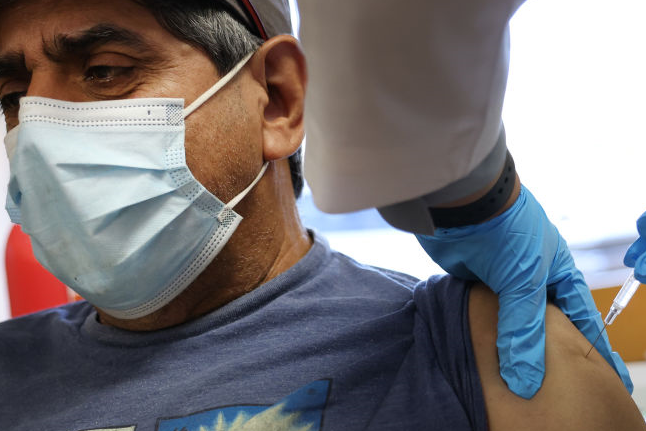Q&A on Omicron-Updated COVID-19 Boosters
Earlier this month, the U.S. began administering the first COVID-19 booster vaccines that have been updated to better match the latest circulating coronavirus strains.
Many scientists expect the revised boosters will be more effective than their predecessors, but whether that’s the case and to what degree remains unknown.
 The new vaccines, from mRNA vaccine makers Pfizer/BioNTech and Moderna, are bivalent, meaning that along with the original version of the coronavirus, or SARS-CoV-2, they also specifically target the BA.4 and BA.5 omicron subvariants. At the end of August, the Centers for Disease Control and Prevention estimated that together the two subvariants accounted for more than 90% of new COVID-19 cases in the U.S.
The new vaccines, from mRNA vaccine makers Pfizer/BioNTech and Moderna, are bivalent, meaning that along with the original version of the coronavirus, or SARS-CoV-2, they also specifically target the BA.4 and BA.5 omicron subvariants. At the end of August, the Centers for Disease Control and Prevention estimated that together the two subvariants accounted for more than 90% of new COVID-19 cases in the U.S.
The Food and Drug Administration authorized the retooled boosters on Aug. 31, and the CDC signed off on the shots the following day, after the agency’s vaccine advisory committee voted 13 to 1 to recommend both boosters.
The authorizations mark a shift in American COVID-19 vaccination policy. In what’s being called a “fall booster ‘reset,’” people will no longer count the number of vaccine doses they’ve received. Instead, the guidelines are simple: If you’ve had your primary series (one dose of J&J or two doses Pfizer/BioNTech, Moderna or Novavax) and it’s been at least two months since your last dose, then you’re eligible for one omicron-updated booster.
We’ll explain how the new vaccines are different and what experts are saying about them.
How are the updated shots different from the original ones?
The revised boosters are essentially identical to the original ones, except for a tweak to some of the mRNA included in the shots.
For both Pfizer/BioNTech and Moderna, half of the mRNA in the vaccine includes the instructions used in the earlier vaccines for cells to make the spike protein of the original coronavirus strain. The other half includes the instructions for making the spike protein of the BA.4 and BA.5 strains, which is the same in the two subvariants. The spike proteins trigger a protective immune response in the body.
The dual components are why the boosters are referred to as “bivalent.” For the same reason, you may hear the original vaccines being called “monovalent.”
As before, the new Pfizer/BioNTech booster contains a total of 30 micrograms of mRNA, matching the dosage of the primary series shots, while the revamped Moderna booster contains a total of 50 micrograms, or half of the dosage of the primary series.
Who is eligible to get an updated booster?
People 12 years of age and older are eligible to receive Pfizer/BioNTech’s updated booster and adults 18 years or older are eligible to receive Moderna’s updated booster, two or more months after a previous COVID-19 vaccination.
It doesn’t matter if you’ve never been boosted or if you’ve received multiple boosters already — everyone who meets the age requirements and has had their primary vaccinations can get the updated booster as long as they are two months or more out from their last COVID-19 dose. (If you’re still not sure if you’re eligible, you can take an online quiz from the CDC to find out.)
The updated boosters are only authorized as booster shots, so they can’t be given to people as primary vaccinations. For the specified populations, the updated boosters are also replacing the earlier versions of the boosters, which are no longer authorized. As a result, all booster doses will be the bivalent ones — except for kids 5 to 11 years old, who are currently only eligible to receive Pfizer/BioNTech’s original booster dose for their age group.
What evidence supports the use of these omicron-updated boosters?
To authorize the updated boosters, the FDA borrowed its approach for influenza vaccines, which each year are modified to match the flu strains that are expected to circulate that season. Because the changes are only tweaks — and because it would be impractical if not impossible to test the vaccines in people prior to the flu season — flu vaccines are approved without doing clinical studies each year.
The omicron-updated boosters are similar in that they have not yet been evaluated in people, although there is other supporting evidence to suggest that they will work. For one, there is clinical data on a slightly different omicron-specific bivalent booster that targets the BA.1 subvariant that was dominant earlier this year.
Moderna tested this booster in about 600 adults who had received two primary doses and one original booster, and at least three months later were given a second original booster or a BA.1 bivalent booster. In blood tests, there was a stronger antibody response a month out in those who had received the BA.1 booster against both BA.1, BA.4/5 and the original virus, as well as against a variety of other variants.
The Pfizer/BioNTech BA.1 bivalent booster was tested in a similar way, in about 600 people over the age of 55, with a median of about six months in between the booster doses. At one month, the antibody responses to BA.1 were better in those who had received the BA.1 booster than the original, and the antibody responses to the original virus were similar in the two groups.
Although similar studies are being done in people for the BA.4/5 bivalent booster now, those results aren’t in yet. However, experiments from both companies show that mice previously vaccinated and then boosted with the bivalent BA.4/5 vaccines have higher BA.5 neutralizing antibody responses than those boosted with the original vaccine.

Moderna also challenged, or intentionally infected, vaccinated and boosted mice with BA.5 and found animals who received the bivalent BA.4/5 booster were better protected in their lungs than those boosted with the original vaccine.
An unpublished study posted as a preprint following authorization of the new boosters also found that mice given Moderna’s BA.4/5 booster had a stronger and broader antibody response compared with those given the original booster, which appeared to translate into better protection against BA.5 in the lung.
Fox News host Tucker Carlson and some posts on social media have highlighted the lack of clinical data on the BA.4/5 boosters, noting that the specific vaccines have only been given to eight mice. That’s mostly true (Pfizer lists eight, while Moderna shows 10), but it’s misleading to suggest that’s the only information scientists have on these shots.
As we said, the revised boosters are not entirely new vaccines. Regulators considered the abundance of data indicating the original shots are safe and effective, particularly against severe disease, and they had the clinical data from the highly similar BA.1 bivalent boosters along with the animal data.
Moreover, as was pointed out during the CDC’s advisory meeting, the companies now have several years of experience with the animal models and have consistently seen that they correlate well with human immune responses.
Still, some experts have been wary of moving forward with a new COVID-19 booster without human data on these specific vaccines. Dr. Pablo Sanchez, a professor of pediatrics at the Ohio State University and a member of the CDC’s vaccine advisory committee, ultimately voted against recommending the new boosters because of that concern.
“I voted no because I really feel that we need the human data,” he said during the meeting. “There’s a lot of vaccine hesitancy already. We need the human data.” Nonetheless, Sanchez said that, given his age, he was “almost sure” that he would take it.
The rest of the committee, though, felt comfortable enough, given the precedent with flu, to recommend the boosters.
Numerous other countries have opted to go with updated BA.1 bivalent vaccines, which do have clinical data (although the European Medicines Agency, which recommended BA.1-adapted boosters in early September, also recommended the BA.4/5 boosters on Sept. 12). The FDA, however, decided that the best strategy would be to target BA.4/5, since BA.1 is already no longer circulating.
The agency could have waited for the clinical data on BA.4/5, but thought that doing so would sacrifice too many lives. Estimates from the COVID-19 Scenario Modeling Hub suggest that delaying the booster campaign by a month would result in 137,000 more hospitalizations and 9,700 more deaths.
“We have to be a step ahead, or at least we have to try,” FDA chief Dr. Robert Califf explained in a press conference following the authorization of the new boosters. “Because if we waited for all the proof to come in, the wave will have already passed us by and the damage will have been done.”
E. John Wherry, an immunologist at the University of Pennsylvania, said the difference between BA.1- versus BA.4/5-targeted boosters was likely to be small, but given the choice, he would also opt for BA.5.
“This will not be the last version of the vaccine that we see,” he said. “Going with what’s here currently makes a lot of sense to me.”
As for when the human data on the bivalent BA.4/5 booster will be available, Dr. Peter Marks, the head of vaccines at the FDA, said on Aug. 31 that it would probably be at least until the end of September or October, “because of the time it takes to actually dose and then do the assays.”
How effective are the new boosters?
Scientists don’t know how well the redesigned shots will work. In theory, the omicron-updated boosters should be better than the original boosters in protecting against disease because they will more specifically target the coronavirus strains currently circulating — and some data suggest that will be the case.
It’s also possible the updated boosters will prevent more infections, although that protection will be short-lived.
But as the World Health Organization has said, “The full public health benefit of variant-updated vaccines and their value proposition over current vaccines can only be quantified once vaccine effectiveness data have been obtained.”
The real question is not whether the booster will increase protection — they will, scientists told us — but whether and to what degree the updated booster will be better than the original boosters.
Wherry said he thought the new boosters would be better, but the difference would likely be modest.
“I think it’s important to not give the false sense of hope that this new bivalent vaccine is going to be a magic bullet that stops all omicron viruses,” he said. “We should be expecting that they keep the most vulnerable people out of the hospital, but we should not be expecting them to completely protect from, say, mild disease.”
Dr. Paul A. Offit, a vaccine expert and pediatrician at the Children’s Hospital of Philadelphia, is not convinced that the updated boosters will be an improvement.
“I think they’re all going to be of value, I don’t think they’re necessarily going to be of any greater value than just boosting with the ancestral strain,” he said. “What worries me in all this is … that it’s sort of being oversold, being overpromised,” Offit added. “I just fear that people might be disappointed.”
How safe are the new boosters?
The exact formulation found in the new boosters has not yet been tested in people, but the revised vaccines are very similar to the original vaccines that have now been given hundreds of millions of times in the U.S. alone and have been shown to only very rarely result in serious side effects.
In addition, both companies tested the slightly different BA.1 omicron-specific bivalent booster in people, and found no new safety concerns. Vaccine recipients reported experiencing the same expected and temporary side effects as the original shots, including pain, redness and swelling at the injection site; fatigue; headache; muscle pain; and fever.
Given the similarity in design and manufacturing process as the original vaccines, the FDA felt very confident authorizing the boosters. Other experts also told us there is no reason to think that the revamped boosters will pose any new safety hazards. Offit, for example, said it was “extremely unlikely” that the new boosters would be any different in terms of safety.
Notably, Sanchez, the sole dissenter on the CDC’s advisory committee, explained after his “no” vote that while he felt there needed to be clinical data to be able to recommend the boosters, he was not that worried about safety.
“I am comfortable that the vaccine will likely be safe like the others,” he said, adding that he would almost certainly get the new booster himself.
Like the original vaccines, scientists do expect the updated shots will carry a small increased risk of myocarditis and pericarditis, or inflammation of the heart muscle and its surrounding tissue, particularly in young males. Most people who are affected by the rare side effect and are treated, the CDC says, feel better quickly.
Another issue being monitored by scientists is whether boosting could hurt a person’s ability to respond to a future variant, as we have written. But Wherry, who has been following this topic, said there is no indication that is a current risk. “From the data that exists, I see no concern about that whatsoever,” he said. Some animal studies suggest that giving an omicron-only vaccine as a first vaccine dose in animals could be detrimental, he added, but that’s not what is being given to people.
What do experts say about who should get the updated shots, and when?
There is broad agreement that older people and those at higher risk of developing severe COVID-19 should get the new boosters. But experts differ on whether young, healthy people should get another dose.
“I don’t think that a healthy young person who has already received three doses frankly needs another dose, because I think they are protected against serious illness,” Offit said. “After about six months after their last dose, they’re not going to be as protected against mild illness, but that’s true of all infections like this one, meaning short incubation period, mucosal infections.”
Offit still recommends that people over 75 years old, those with significant underlying health problems and those who are immunocompromised seek out the shots. Those are the groups, he said, that have benefited from the previous boosters.
But others think it’s reasonable to give the shots more widely, and that younger people should at least consider them.
“Most young, healthy people are protected from severe disease even after three doses and that protection is pretty durable,” Wherry said. The updated booster, he said, is primarily meant to protect the most vulnerable and to perhaps offer a little bit better protection from mild or moderate disease.
“If you’re over 65, everyone should get boosted,” he said. “If you have comorbidities or are immunosuppressed, absolutely get boosted.”
For younger people, Wherry said boosters are still a good idea, but there can be more individual choice — and that people shouldn’t think that the booster will make them impervious to infection.
“I would encourage people to think about their own behavior and when the right timing for the boost would be,” he said. “If you last got a dose of vaccine or were last infected three months ago and you’re a middle-aged, otherwise healthy individual, you may consider waiting a month or two and time your next dose closer to the holidays or closer to when there’s going to be more indoor activities so that peak level of antibodies coincides with when you’re going to be attending family gatherings or be inside more.”
Although two months is the minimum amount of time to wait since the last COVID-19 dose before getting the updated booster, many experts, including Offit and Wherry, suggest that people wait longer than that since last being vaccinated or being infected with SARS-CoV-2.
“The science really says for a young, healthy individual, you’re going to get the best boosting if you wait four to six months,” Wherry explained. “That allows for your memory B cells and memory T cells to mature a little bit, antibody levels to come down from their sort of max peak level after infection or vaccination.”
But for people who are older or have health problems, Wherry suggested consulting a doctor, because those individuals might need to get their doses sooner.
Is this the start of a shift to an annual COVID-19 vaccine?
Maybe. The Biden administration has presented this fall’s booster as the first of a once-a-year shot for COVID-19, similar to an annual seasonal flu vaccine. But while that could be a reasonable approach, it’s too early to truly know.
Some federal health officials have said as much, noting that new variants might disrupt those plans and that older or high-risk people might need more than one vaccine a year. Some experts, including Offit, are critical of the administration for getting ahead of itself on this question. Offit told us it was reasonable to target high-risk groups, but that young, healthy people may not need an annual boost.
Others are more comfortable with the concept. Wherry, for instance, said that given data that protection against severe disease begins to wane a little around nine months, the one-year time frame makes sense as “a benchmark for the average person” — and also is practical.
“A bit of aligning to traditional health care is an important part of this because it’s actually going to help with vaccine compliance, keeping up with what’s new,” he said, adding that there would remain flexibility for higher-risk people, who likely already interact more with the health care system, to get additional doses if needed.
Where can I get an updated booster?
You can find where the new boosters are available in your area by visiting Vaccines.gov. As with other COVID-19 vaccines, the reformulated boosters will be available at pharmacies, community health centers, and some clinics and doctor’s offices. But a lack of funding means they are less likely than the earlier shots to be available in various public health outreach efforts.
In some places, the boosters may be difficult to find at first. Certain locales have reported shortages of the Moderna vaccine in particular in the first weeks of the rollout, in part due to the delayed release of 10 million doses from a packaging plant in Indiana.
Again, the only booster available to people 12 years and older will be the updated one, so even if it’s not advertised as being new or bivalent, that’s what you will receive.
Are the shots still free?
Yes. The U.S. government has purchased more than 170 million doses of the updated boosters, and at this time, all COVID-19 vaccinations remain available to the public free of charge, regardless of immigration or insurance status.
The administration, however, has warned that without additional funding, it expects it will need to transition COVID-19 vaccine costs “to the commercial market” as early as January. When that occurs, the vaccines will likely be covered for most people with health insurance, similar to flu and other vaccines. People without insurance, however, would need to pay out of pocket.
Can I get my updated booster along with my flu shot?
Yes. Health officials are suggesting this pairing be offered to you this fall, since they know that getting both in one go is more convenient and increases the likelihood that you’ll get both vaccinations.
After one nearly nonexistent and one mild flu season — likely thanks to COVID-19 mitigation measures — some experts are concerned this flu season might be worse than normal. The relative lack of flu for two years running likely means there is less immunity in the population and more people will be susceptible. Clues from the Southern Hemisphere, which often presage flu severity in the North, have been mixed. Australia has had a bad flu season in terms of the number of cases, raising concerns — but other countries have not had particularly active seasons.
Regardless of how severe the flu season turns out to be, vaccination is still recommended. Several studies, along with surveillance data, indicate that getting a COVID-19 shot at the same time as a flu shot is safe and doesn’t reduce your immune response to either virus. The temporary, expected side effects of vaccination are usually on par with or only slightly worse in people getting both shots compared with those just getting a COVID-19 dose.
For some individuals, getting the shots together may make sense, but for others, the timing might not be ideal. The CDC recommends getting the flu shot in September or October, but many experts recommend October or later because vaccine protection against flu wanes and may not last the entire season if given too early. Still, getting the flu vaccine a bit early is better than not getting it at all.
If you opt for dual vaccination, you should get the two shots in different arms or in the same arm with the injections at least an inch apart.
This year, for the first time, the CDC is preferentially recommending that people over 65 years of age get a high dose or adjuvanted flu vaccine instead of a standard flu vaccine, given evidence that those shots may work better for this group.
When will kids be able to get updated shots?
Teens 12 and older are eligible for Pfizer/BioNTech’s omicron-updated booster, but the wait is likely to be at least a few more weeks for younger kids.
On Sept. 21, the head of vaccines at the FDA said that the agency was “only a matter of weeks away” from authorizing updated boosters for kids 5 to 11 years old and “a few months away” for children under 5. The day before, the CDC released a planning document saying it expected Pfizer/BioNTech’s booster for 5- through 11-year-olds and Moderna’s booster for 6- to 17-year-olds in “early to mid-October.”
Pfizer and BioNTech had previously said that they expect to submit their EUA application for updated boosters for children 5 through 11 years of age in early October and that they were pursuing an application for the youngest children down to 6 months.
As with the new boosters for those 12 and up, there may not be clinical data in children for the specific vaccine prior to authorization.
At the CDC’s advisory committee meeting, a Moderna representative said that the company would be completing its EUA submission for its original booster vaccine in kids 6 through 17 by mid-September. The company, she said, is currently conducting a study of primary series BA.1 bivalent vaccines and original and BA.1 bivalent boosters in children 6 months to 5 years old, which is expected to be finished by the end of 2022. She added that Moderna was “exploring” ways of testing BA.4/5 bivalent vaccines in children for use as primary vaccinations and boosters.
Editor’s note: SciCheck’s COVID-19/Vaccination Project is made possible by a grant from the Robert Wood Johnson Foundation. The foundation has no control over FactCheck.org’s editorial decisions, and the views expressed in our articles do not necessarily reflect the views of the foundation. The goal of the project is to increase exposure to accurate information about COVID-19 and vaccines, while decreasing the impact of misinformation.
This article has been archived for your research. The original version from FactCheck.org can be found here.


